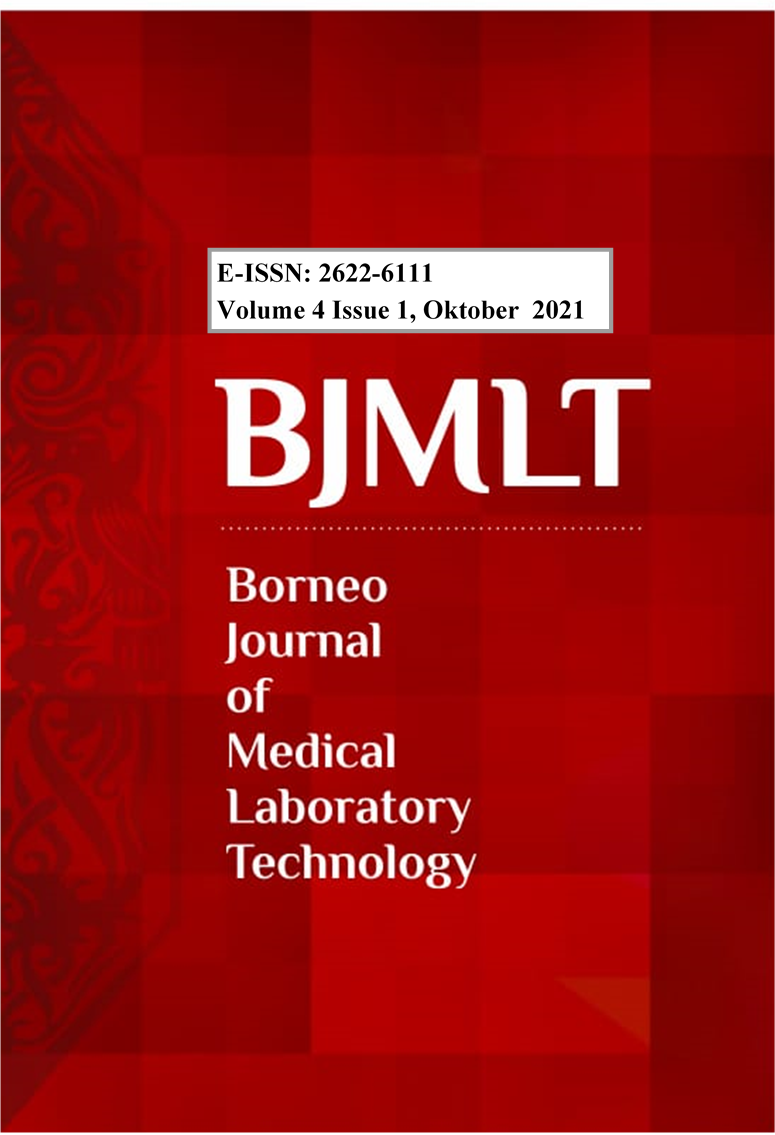Perbedaan Hasil Pemeriksaan Hemoglobin dengan Point of Care Testing (POCT) pada Sampel Darah Vena dan Kapiler Differences in Hemoglobin Test Results with Point of Care Testing (POCT) in Blood Samples Veins and Capillaries
Main Article Content
Abstract
On examination of hemoglobin with POCT generally use capillary blood. The use of capillary blood as a test sample has a deficiency, namely the possibility of dilution in capillary blood samples caused by a deep puncture so that the blood that comes out is not smooth and usually the fingers will be pressed or sequenced. This condition can cause blood dilution by tissue fluid, so the test results will tend to be low. The purpose of this study was to find out the difference in hemoglobin results with POCT in venous and capillary blood samples. This study uses descriptive analytical methods that aim to describe or describe a situation objectively, and then describe it. The results showed the average hemoglobin level in the venous blood sample was 13.2 g/dl. While in capillary blood samples 12.9 g / dl. The results of the independent t-test obtained a significance value of 0.224 (p > 0.05) so it can be concluded that there is no significant difference between the results of hemoglobin levels examination using venous blood samples and capillary blood samples.
Downloads
Article Details
All rights reserved. This publication may be reproduced, stored in a retrieval system, or transmitted in any form or by any means, electronic, mechanical, photocopying, recording.
References
Eslami, Z., Ghilian, R., Abassi, F. 2012. Evaluation of Hemoglobin Concentration of Cord, Capillary and Venous sampling in Neonates. Iranian Journal of Pediatric Hematologi Oncology, 2 (4), pp 159-163.
Faatih, M. 2017. Penggunaan Alat Pengukur Hemoglobin di Puskesmas, Polindes dan Pustu. Jurnal Penelitian dan Pengembangan Pelayanan Kesehatan, 1(1) : 32–39.
ICSH. 1996. Recommendations for haemoglobinometry in human blood (ICSH standard 1995) and specifications for international haemoglobincyanide standard. 4th editions. J Clin Path. 49: 74-271.
Khasanah, Uswatun. 2016. Perbedaan hasil pemeriksaan hitung jumlah trombosit pada darah vena dan darah kapiler dengan metode tabung. Skripsi. Universitas Muhammadiyah Semarang, Semarang.
Nidianti, E., Nugraha, G., Aulia, I. A. N., Syadzila, S. K., Suciati, S. S., & Utami, N. D. 2019. Pemeriksaan Kadar Hemoglobin dengan Metode POCT (Point of Care Testing) sebagai Deteksi Dini Penyakit Anemia Bagi Masyarakat Desa Sumbersono, Mojokerto. Jurnal Surya Masyarakat, 2(1) : 29-34.
Prasetya, H. R., Dentri, M. I., Sistiyono. 2016. Perbedaan Hitung Jumlah Trombosit Menggunakan Darah Vena dan Darah Kapiler. Journal Of Health 3(2). 62-117
Puspitasari., Aliviameita, A., Rinata, E., Yasmin, R. A. Y., & Saidah, S. N. 2020. Perbedaan Hasil Pemeriksaan Hemoglobin Antara Metode Point of Care Testing Dengan Metode Sianmethemoglobin Pada Ibu Hamil. Jurnal Analis Kesehatan, 9(1) : 24.
Rosidah, & Rahmawati, N. K. 2016. Perbedaan Kadar Hemoglobin Metode Sahli pada Darah Vena dan Kapiler di Puskesmas Tikung Desa Bakalan Pule Kec.Tikung Kab.Lamongan. Jurnal Sains, 6(11) : 21–26.
